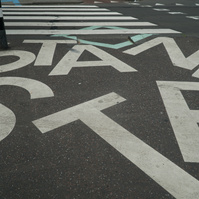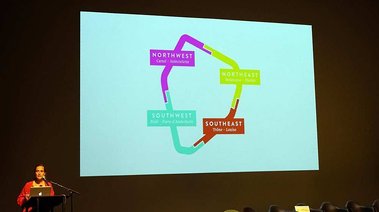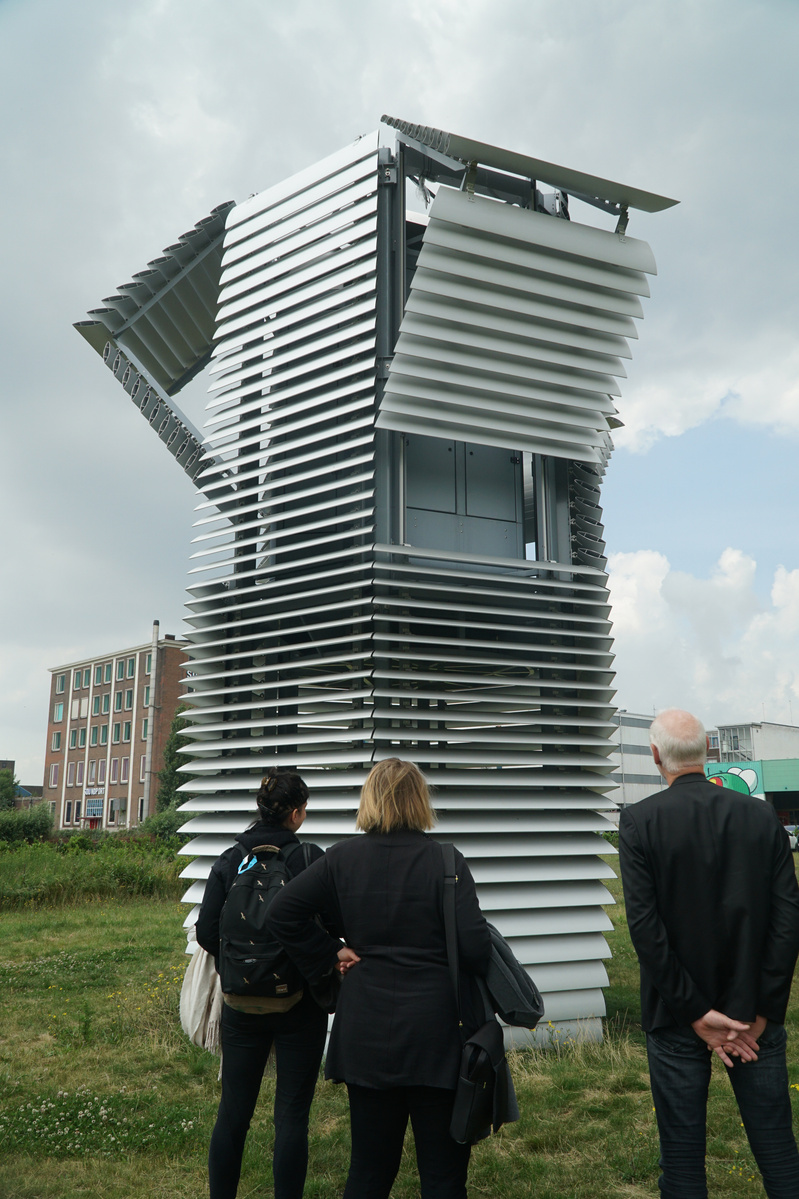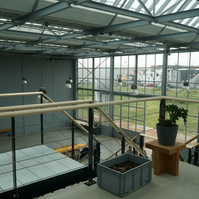Rotterdam
June 13-17
After a sleepless trans-Atlantic flight from New York to Dublin to Amsterdam, I sought to beat the impending jet lag by setting out on a bike ride through the city of Rotterdam. With my uncle's trusty Gazelle bike, I rode for four hours through several neighborhoods to get a feel for the city.
City in Context
Rotterdam is the second largest city of the Netherlands and is part of the greater "Randstad" region, a megalopolis consisting other cities including Amsterdam, The Hague, and Utrecht. The city of Rotterdam was in a unique position after much of the city center was destroyed during World War II. An opportunity to reconstruct the city in a new manner had the potential to solve a number of major urban issues. From the outset, the guiding principle was to completely redesign the center, rather than restore the original street grid and repair important buildings.
At the time of reconstruction, the Modernist movement was in vogue among urban planners and architects. One of the key features of this style of development was the separation of functions and building uses, with offices and shopping located in the city center and housing in the outlying suburbs. This was implemented via the adoption of the Basic Plan, a legal framework to allow for the city to build quickly and consciously.
The Basic Plan also had important mobility implications. The street pattern was transformed into a more regular grid of major traffic arteries. Hofplein, a complicated intersection with a modern Palace of Industry in earlier proposals, became a massive traffic circle in Van Traa’s plan. The main boulevard Coolsingel became an 80 meter wide artery. The Basic Plan was so flexible that the street pattern evolved from city center courtyards into the revolutionary, pedestrian Lijnbaan shopping development.
But over the years, further development and increased use of the city's road network caused issues around the city in terms of congestion. Since 2006, the average speed on city roads has decreased, and the number of vehicle kilometers has also risen. What's more, the city's air quality is poor, with the level of NOx and PM being 70 and 25 percent higher than rural areas in the Netherlands, respectively. Pollution and noise levels exceed standards set by European guidelines.
To tackle these problems, Rotterdam has emphasized delivering clean urban transport for people. In particular, the city sought to increase mode share in favor of public transport and bicycle and to reduce congestion, air and noise pollution, and car kilometers traveled. What have the city and other stakeholders done to accomplish this?
Integration of cycling and public transport
This came in the form of bicycle parking near metro stations, with various services including bicycle maintenance and repair stations. This included several options for obtaining a bike if you didn't have one handy, including Mobike, OV-fiets, and Donkey Republic.
Expansion of car sharing
To encourage people to use smaller and cleaner cars, Rotterdam has permitted car sharing companies like Greenwheels and Juuve to operate in the city. Studies by the Dutch government saw the implementation of such schemes as successful in reducing vehicle miles traveled by 20%, and over 30% less car ownership among car sharers than before they began car sharing.
Public transport priority and dedicated lanes
The RET (Rotterdam's PT authority) introduced the TramPlus high quality tram service by providing more right of way exclusively to tram vehicles. This has since been expanded to several bus lines as well. Dedicated/priority lanes improve headway times for transit vehicles and reduces delays, improving efficiency and reliability of the public transport system.
International Architecture Biennale Rotterdam
During my time in Rotterdam I also attended IABR's 2018 edition of biennial archiecture exhibition in Rotterdam. This year, the curators focused on bridging the gap between the status quo and goals set forth by the Paris Climate Agreement (COP 21) and the UN's Sustainable Development Goals.
The IABR–2018+2020–THE MISSING LINK focuses on the question of how we can effectively realize the urgent acceleration and scaling of the transition to a resilient future. In the run-up to tackle this major challenge, the IABR first focuses on the Delta of the Low Lands, in which research by design takes place with various provinces and municipalities in the Netherlands and in Belgium.
The Missing Link will spend the three coming years developing new practices along several areas, but of most interest to my study is the development of a "New Mobility System."
Towards a New Mobility System
Curators remarked that the Low Lands can boast a generous and fine-meshed water, rail, and road network, but is reaching its limits due to increasing suburbanization and spatial fragmentation. As a result, trip movements are increasing and traffic congestion is becoming more common. Paradoxically, the construction of new infrastructure leads to more congestion and stagnation of the mobility system.
This evolution not only makes the people of the Low Lands less mobile, but also reduces the availability of precious open space. What's more, the environmental implications of unchecked urban growth cannot continue if the goals of COP 21 are to be met. The general quality of the environment is compromised. Instead, the Biennale exhibition offered a new approach to mobility in the Delta of the Future. Some of them are presented here.
Mobipunt
"Mobipoints" are hubs for different modes of transportation at the neighborhood level. A mobipoint consists of a parking lot for car sharing, bicycle parking and a nearby public transportation stop. Mobility organizations Taxistop and Autodelen.net promoted the idea of mobipoints in Flanders after hearing about the concept in Bremen (Germany) and Bergen (Norway).
Several Flemish cities currently have car-sharing stands that also connect with other modes of transportation. These mobipoints can increase the number of sustainable movements to the detriment of single-occupant car use. This vision shows that shared mobility transfer points can be the public spaces in the city of tomorrow.
WegenWerken ("Road Works")
Growing numbers of non-motorized vehicles are of increasing importance and becoming vital links in the intermodal transportation network. Since Genk is very much a "Car City", Trage Wegen is focusing on the versatile use of slow roads as commons and as city makers. The bottom-up inventory of missing links in the mobility network activates strategic connections that take existing spatial and social contexts into account via participatory planning. The process reflects on their importance in linking different, presently disconnected, neighborhoods and providing a meaningful infrastructure for slow movement in a car-dominated city. The project hopes to coordinate the construction of a multi-functional network to create a new, widely supported mobility vision that goes beyond the urban grid.
Bye Bye Kleine Ring (Bye Bye Little Ring Road)
This project proposed the redesign of Brussels' Kleine Ring with a view toward urban development, better accessibility and the improvement of the living envrionment. Several Brussels citizen platforms and academic organizations have come together to rethink one of the city's most important traffic infrastructures, and to put the issue of mobility on the political agenda in a implemention oriented way. The residents of Brussels are outlining the renovation of the city's Kleine Ring together, turning a political debate about mobility and public space into a co-created urban project.
Studio Roosegarde - The Dream Factory
After visiting the exhibition at the Biennale, I had the opportunity to tour the offices of artist Daan Roosegarde a few steps away from the HAKA Building. He and his team at Studio Roosegarde are known to bring innovative solutions to the urban realm. The visit to his studio underscored Roosegaarde's commitment to the driving concept behind many of his projects: "Schoonheid." This is a typical Dutch word which has two meanings: ‘cleanliness’ as in clean air, cleanwater, clean energy, and ‘beauty’ as in aesthetics and creativity. Two of his projects are closely related to urban mobility: the smog free bicycle and the van Gogh path. When meeting Daan, he emphasised the need for tradional infrastructure developers to create exciting new worlds with creatives. In his TED talk, Daan talks about creativity being the ultimate form of human capital. Throughout my year of travel, I will be sure to seek out practices that incorporate "Schoonheid" to create better conditions in cities such as Rotterdam. In this manner, change in the mobility system of our cities can make them livable again by rethinking processes and upgrading urban structures for a better quality of life.
The Erasmusbrug
As a civil engineer, I can never pass up visiting a good bridge. One of Rotterdam's iconic structures, the Erasmusbrug, spans more than 800 meters (half a mile) across the Maas River and links the northern and southern parts of Rotterdam. The suspension bridge has a 139-metre high steel pylon, which is secured with 40 cables, as shown below. The bridge is nicknamed The Swan, given the asymmetrical shape of the pylon that the steel cables are attached to. The bridge features two-way traffic for pedestrians, cyclists, motorists, and public transportation alike. Thus the Erasmus Bridge is the icon of Rotterdam, from architectural, engineering, and mobility viewpoints.










































